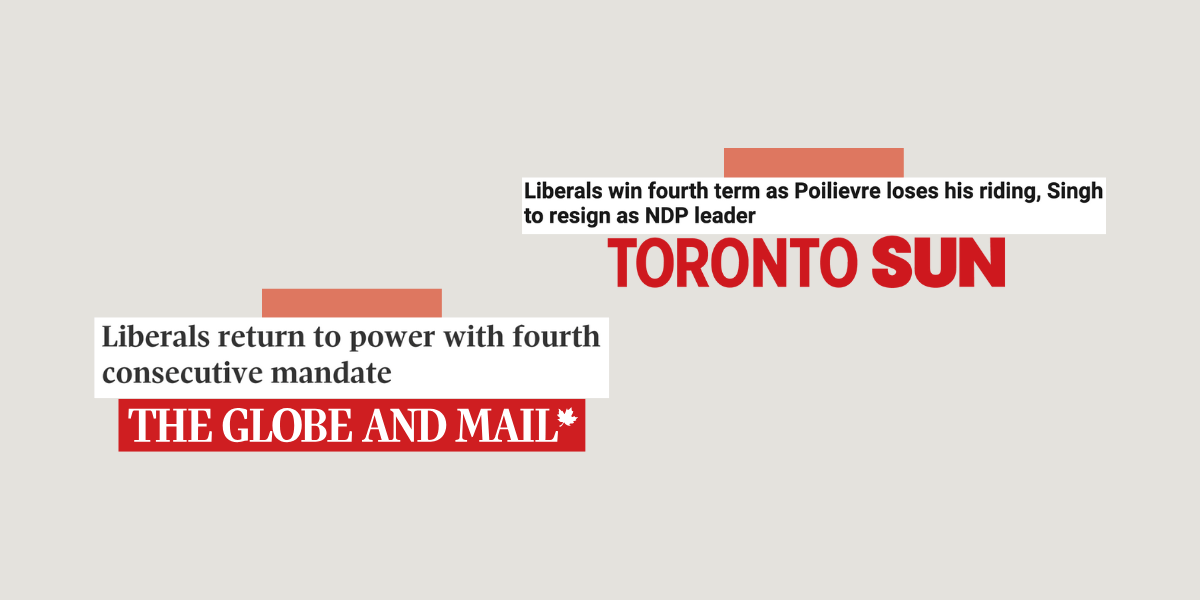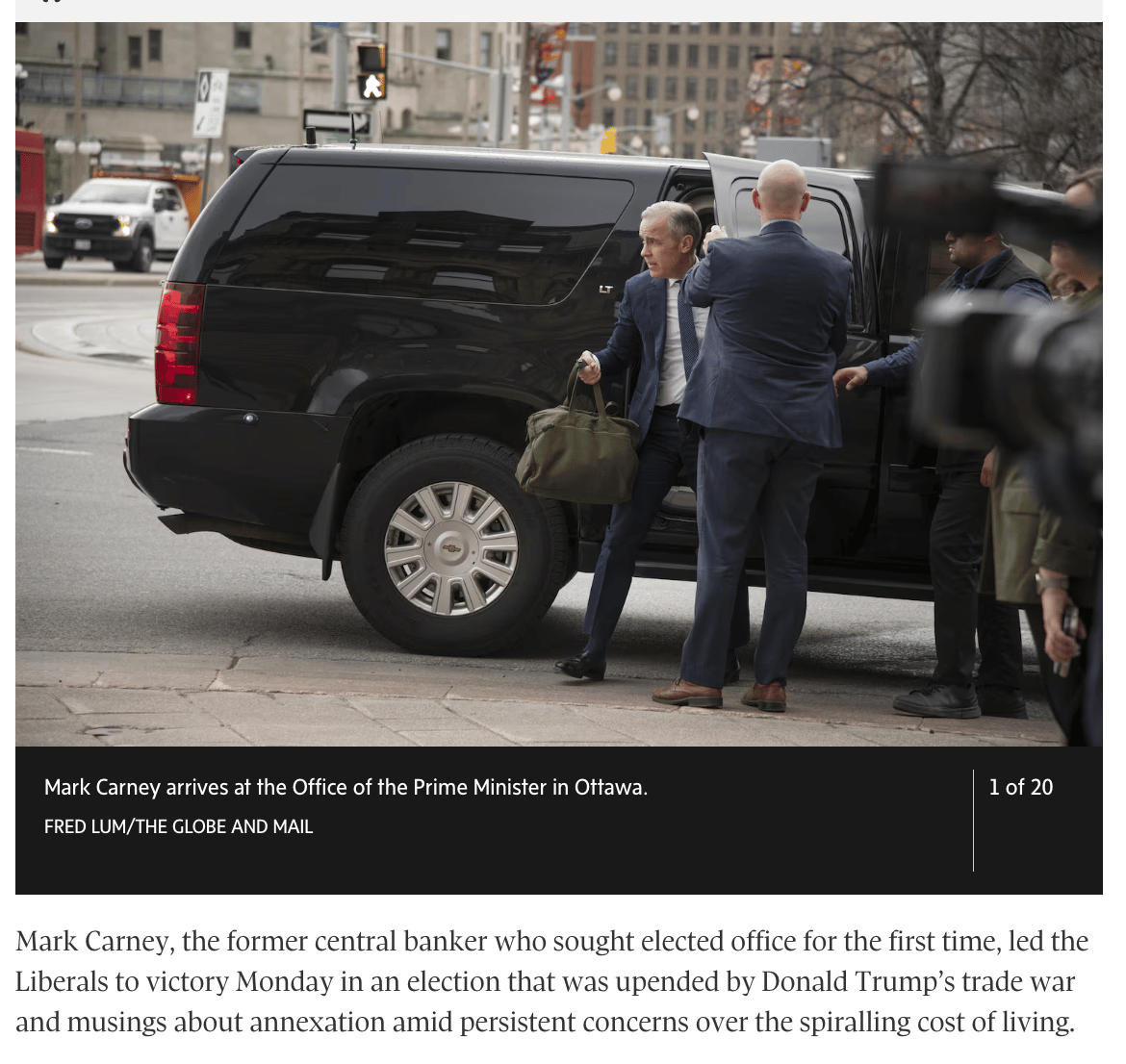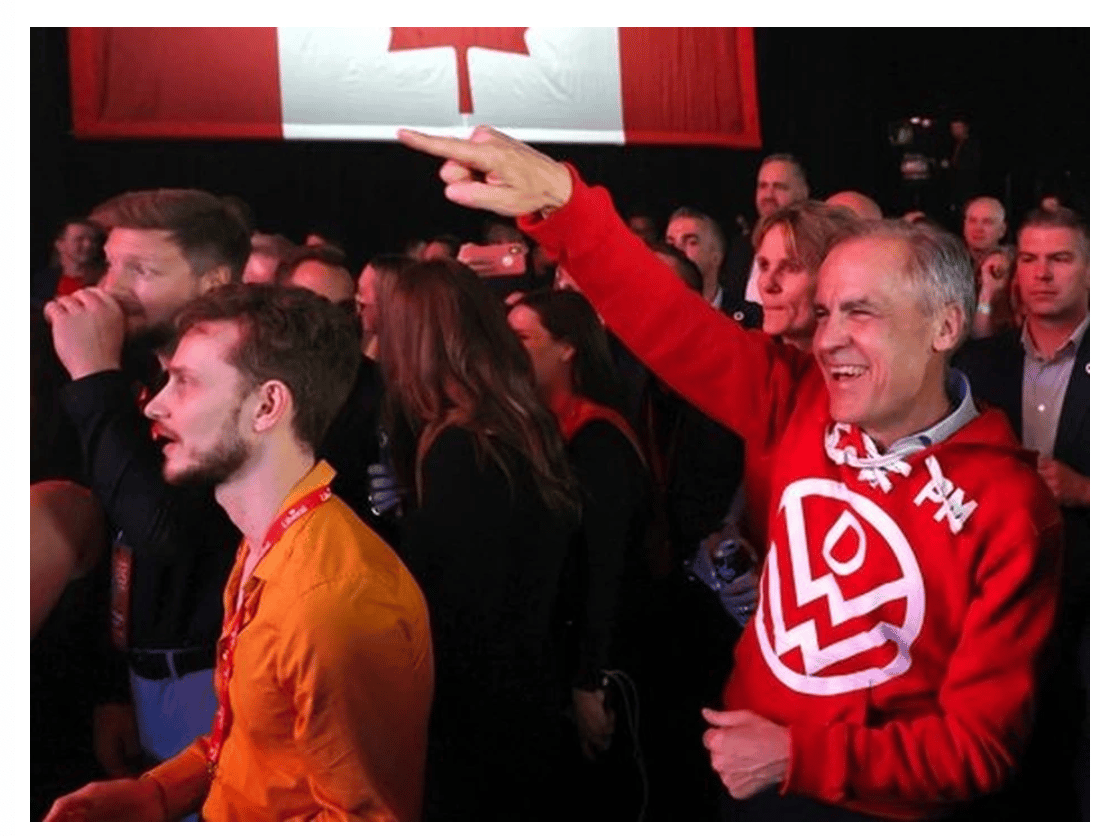- Signpost
- Posts
- 🇨🇦 Canada: Carney convinces country, confounding Conservatives, critics!
🇨🇦 Canada: Carney convinces country, confounding Conservatives, critics!
The greatest Liberal turnaround in Canadian electoral history.

What the media says, what it means, and why it matters.
Was this forwarded to you? Signpost is a free weekly newsletter analysing what the media says, what it means, and why it matters. It’s free to subscribe. Alternatively, you can add me on LinkedIn.
Hi Signposter. Election season is truly underway in 2025, and as you read this, citizens in Singapore and Australia are heading to their nearest polling booth to cast their vote on who will be the next leader of their nation. The following week, 135 cardinals will gather in Vatican City to elect the next leader of the Catholic Church. In June, South Korea will elect their next president.
One big election is already done and dusted. Earlier this week, Canada elected to keep their Liberal Party prime minister Mark Carney in power, a stunning turnaround considering earlier this year the party was expected to cede place to the Conservatives. A conservative election victory was not only in line with the election results of several western liberal democracies, but most of the elections in 2024 were highly anti-incumbent. Even I wrote in the January 11th edition of Signpost that ‘opinion polls predict a Conservative Party win’… so what happened?
That’s the story for this issue of Signpost.
P.S.: This is also the first follow up story of Signpost, which feels like an achievement. Go here to read the previous issue.
THE STORY SO FAR
🏁 A fourth consecutive Liberal Party term

At the time of Justin Trudeau’s resignation on January 6th 2025, market research company IPSOS posted that support for his Liberal Party remained flat at 20% amongst decided voters, while the opposition Conservative Party grew by one point to 46%, saying ‘conservatives are still on track to win a decisive victory if an election were held tomorrow’.
But the election was not held ‘tomorrow’, and much happened between 6th January and 28th April, the day of the election. Mark Carney, who led the Liberal Party, ended up winning almost 44% of the popular vote, a swing of 11.1 points from the previous election. The expected-to-win Conservative Party also increased their vote share by 7.3 points, but were able to receive only 41% of the votes in comparison.
What caused this dramatic shift in voting patterns in Canada? Common wisdom decrees that it was the behaviour of the leader of Canada’s noisy and nosy neighbour to the south that drove voters into the arms of the Liberal Party. In other words, Donald Trump.
In this issue of Signpost, we will analyse the announcement of Mark Carney’s election win from Canada’s newspaper of record (The Globe and Mail) and Canada’s largest tabloid (Toronto Sun). Both sit on the editorial spectrum of conservatism, but at different hues. Today’s issue will explore how the conservative media in Canada reported on the Liberal Party’s victory.
HEADLINE NEWS
🍁 THE GLOBE AND MAIL: Liberals return to power with fourth consecutive mandate [link]
📢 What The Globe and Mail is saying
The article spends a lot of time quoting the winning candidate while also attempting to explain what exactly led to the considerable turnaround of the destinies of the two major political parties of Canada.
📸 Visuals

The article consists of 5 visuals — two photographs, one photo gallery, one video, and one interactive map showing the electoral results. At the top is the photo gallery, with the first photo of the gallery acting as the lead image of the article. In the photo, we see newly elected Liberal Party (LP) Canadian prime minister Mark Carney arriving at his office. He is photographed as he steps out of his black Chevrolet SUV, which also includes blacked out windows. In his right hand he clutches a khaki-green bag, while he wears a dark blue suit, a white shirt, with a dark blue tie and black shoes. His angle of vision is perpendicular to the view of the camera. The door to his SUV is opened by (one can only assume) his security, who are also dressed in dark suits. Towards the extreme right of the photo is the bokeh of a professional video camera, along with a woman dressed also in a khaki-green jacket.

Further down the article is a photo of the leader of the opposition Conservative Party (CP) Pierre Poilievre. He is standing on stage behind a podium giving a speech. He is mid-sentence, mouth agape, and his left hand is raised in the air, palm facing right, while his right hand is firmly gripping the podium. He is also dressed in a dark blue suit, a white shirt, and a dark tie, with a small flag of Canada pinned to his lapel. The podium in front of him is also dark blue with a large realistic red maple leaf printed on the front, while behind him the dark blue background has the words ‘Canada First’ in English and French printed in a continuous pattern.

Below that is a photo of the leader of the New Democratic Party (NDP) Jagmeet Singh who is also photographed at a speech. However, we only see his bust. He is wearing a bright pink turban, and his flowing moustache and beard is liberally salted with white hair. He is also in a dark blue suit, white shirt, and dark tie. His head is facing down, his eyes are closed, and it is obvious that he is disappointed. Behind him is a blurry background of transient colours from orange to yellow to green, that also shows us his name and the name of the party.
Beyond this is an interactive map showing the election results for each constituency and province in Canada. And towards the end is a video of Carney giving a speech to his supporters, standing behind a ‘We Are Canada Strong’ sign and in front of a bunch of multi-cultural Canadians who can be assumed to be the Liberal Party faithful.
✍🏽 Words
The headline of the article states what is the continuation of a remarkably long stint in power for the Liberal Party in Canada (‘fourth consecutive mandate’) before it goes onto summarise the story in the first few paragraphs. We learn that Carney was a ‘former central banker’ who ‘sought elected office for the first time’, after the election was ‘upended by Donald Trump’s trade war and musings’. The article does mention that the election was ‘much tighter than polls predicted’, before stating the latest results.
Here is where we learn some more unexpected results from the election — the support for the opposition Conservative Party was ‘the highest in almost 40 years’, and yet ‘party leader Pierre Poilievre is projected to lose his Carleton seat’. Such is the reality of the democratic process.
The article then reiterates that while the Liberals won the election, they will still need to govern through a coalition as they themselves did not win enough seats in parliament to form a government independently, which the article ominously explains ‘brings continued instability as the threat of defeat hangs over the government’. However, the scale of the achievement is still branded ‘remarkable’, especially for ‘political rookie’ Carney.
Quotes from Carney follow, including him referencing “America’s betrayal”, along with calls for more challenges and sacrifices. Later in the article, the focus switches to Poilievre who is quoted as saying that the country has chosen a “razor-thin minority government”. After that, the article announces that Jagmeet Singh has chosen to resign as NDP leader following the election.
The second half of the article attempts to explain why such a result occurred, especially since ‘only three months ago […] Conservatives were poised to win a massive majority’, mainly due to ‘voter fatigue with Justin Trudeau’s minority government’. This led to Trudeau stepping down in January and being replaced by Carney as the leader of the party, someone who had ‘economic expertise in handling the 2008 financial crisis and Brexit’ as the former governor of the central banks of both Canada and England. Soon after, ‘Mr. Trump’s tariffs and 51st-state threats led to a Liberal resurgence’, despite the election initially projected as a ‘cakewalk for Mr. Poilievre’, who had spent the previous two years taking shots at Trudeau, but could not convert people beyond that. A quote from a data scientist puts down the initial Conservative Party lead in opinion polls as a “repudiation of the Liberals and dislike of Justin Trudeau”, rather than any specific affiliation towards Poilievre.
Carney is credited for shifting ‘the party (Liberals) to the centre and appeared to neutralize the Conservative attacks by adopting similar policies’, especially appearing to be stronger on rhetoric from Donald Trump. Despite a ‘less than forthright’ phone call with Trump leading to the loss of ‘some of the shine off Mr. Carney’, he still managed to defeat the Conservatives, whom the article admits ‘didn’t know how to respond to Mr. Trump’, with Poilievre persisting with his ‘Trump-like name-calling tactics’, which ultimately did not work.
❓ What it means
The Globe and Mail is 181 year-old newspaper-of-record in Canada, which sits somewhere right-of-centre politically and financially, but has in the past leant more left-of-centre on social issues. It is a highly influential newspaper in the country, and by some measures is the most widely circulated newspaper. In short, people pay attention to what The Globe and Mail says.
The party it is usually most associated with, the Conservatives, did not win this election. The article therefore asserts that the win for the Liberals can be attributed more to Donald Trump than to Carney, calling him a ‘rookie’ who has never won an election. The headline doesn’t even mention Carney by name.
The Conservative leader does not come in for much criticism, nor do the other losing opposition leaders, who barely warrant a mention. However, the article does admit that Poilievre was not personable enough to be voted into the highest office of the land.
⚠️ Why it matters
Portraying Carney’s win as a result of external forces weakens his legitimacy as a leader. Not only is his party set to rule a minority coalition government, if the perspective amongst Canadians is that the only reason he’s there is because of Donald Trump, and not because of his own abilities, then it’s highly likely we may see a third issue of Signpost dedicated to the Canadian elections in 2025.
☀️ TORONTO SUN: Liberals win fourth term as Poilievre loses his riding, Singh to resign as NDP leader [link]
📢 What Toronto Sun is saying
With this being a local newspaper, the article skews very heavily toward local Toronto election results, despite the greater story being the national win of the Liberal Party. The article spends a lot of time listing the results of several local elections, but there is enough content here to gauge the editorial focus of the media.
📸 Visuals

The article has four visuals — first at the top is an image of Carney. Below that is an autoplaying video highlighting election news from the Toronto Sun, following which are two interactive tables listing all the results from the overall elections and from the major cities in the country.
Focusing on the header image, it is a photo of Carney in a red hoodie amongst a group of people. He is smiling widely, he is pointing with his right hand up in the air, and he looks like he’s dancing. He is celebrating at a victory party, while the people around him are seriously standing around looking in another direction and not at him. A large flag of Canada is cut off on the wall above him.
✍🏽 Words
The headline mentions the fourth term win for the Liberals, while also specifically calling out the Conservative and NDP leaders by name, even if in loss. The subheading though mentions Carney by name. The article begins claiming that ‘Canada’s Conservatives got off to a good start’, before admitting ‘it wasn’t enough to hold off a fourth Liberal term’. The article continues to mention the loss of Poilievre and Singh, calling Singh ‘soundly beaten’, leading to a ‘disastrous finish’ for the NDP.
The article continues stating that while results were called earlier in the evening, at midnight ‘the Tories (Conservatives) began a surge of support that closed the gap’, which was still not enough, even though the ‘good showing defied predictions by pollsters and pundits’. The Liberals will form what is called ‘another precarious minority government’.
Following this, the article begins to list the results of all the local Toronto elections and beyond, before sharing ‘other conservative wins'. Finally, the article ends with the mention of the win of ‘Liberal MP Wayne Long, who gained attention for his outspoken opposition to former PM Justin Trudeau’, and the ‘implosion of the NDP, as well as a collapse in support for the Bloc Quebecois’.
❓ What it means
Any doubts about whom the Toronto Sun was supporting? The editorial focus of the newspaper is significantly more obvious than The Globe and Mail, the tabloid being freed from the shackles of historic baggage and the pressure to appear statesman-like. The Toronto Sun mentions the Conservative leader in the headline, and the Prime Minister only in the subheading.
The article also starts off with a positive spin on the performance of the Conservatives, saying that their results could not ‘hold off’ another Liberal victory, almost like enemies at the gates. Every positive spin in the article put on the Conservatives’ performance in the election is unavoidably brought back to reality with the fact that they simply did not win the election. While criticism is projected upon the other losing candidates and parties, particularly Jagmeet Singh and Bloc Quebecois, Poilievre and the Conservatives escape such soul-searching.
Even the picture of Carney used shows him dancing alone, looking ludicrous, almost not fit to be Prime Minister of Canada.
⚠️ Why it matters
As a tabloid newspaper, the Toronto Sun is expected to be more controversial, combative, and scandalous in it’s reporting, which it has managed to lean into (albeit much less so compared to other countries). The Toronto Sun does its best to spin the news into something positive, but the overall story is still one of loss. Editorial bias exists in all media, it’s simply the degree that is leveraged.
WHAT’S GOING ON?
➡️ Not a Night for the Right
I deliberately picked two conservative leaning new outlets for this issue of Signpost to provide some more nuance to the whole left-right media criticism. Often, most people view the media a giant monolithic structure that splits straight down the middle. The reality is that the media is extremely splintered into several niche and nuanced factions, and if you look hard enough you can easily spot the editorial direction (read: bias) in the reporting of the news.
As for Carney, he will have to serve all the readers of all the Canadian news outlets, while forming a minority coalition government. And while Canada has bucked the anti-incumbency trend from 2025 and has instead reinstated their liberal government, does this mean that we can expect similar results in other major democratic elections this year? Or was this simply an anomaly tied to one Donald Trump? Or, is it that Canada truly is, at its core, a liberal society?
The truth, as always, is somewhere in between.
Read widely. Question thoroughly. Decide accordingly.
WEEKLY POLL
LAST WEEK’S POLL

Was this forwarded to you? Signpost is a free weekly newsletter analysing what the media says, what it means, and why it matters. It’s free to subscribe. Alternatively, you can add me on LinkedIn.

